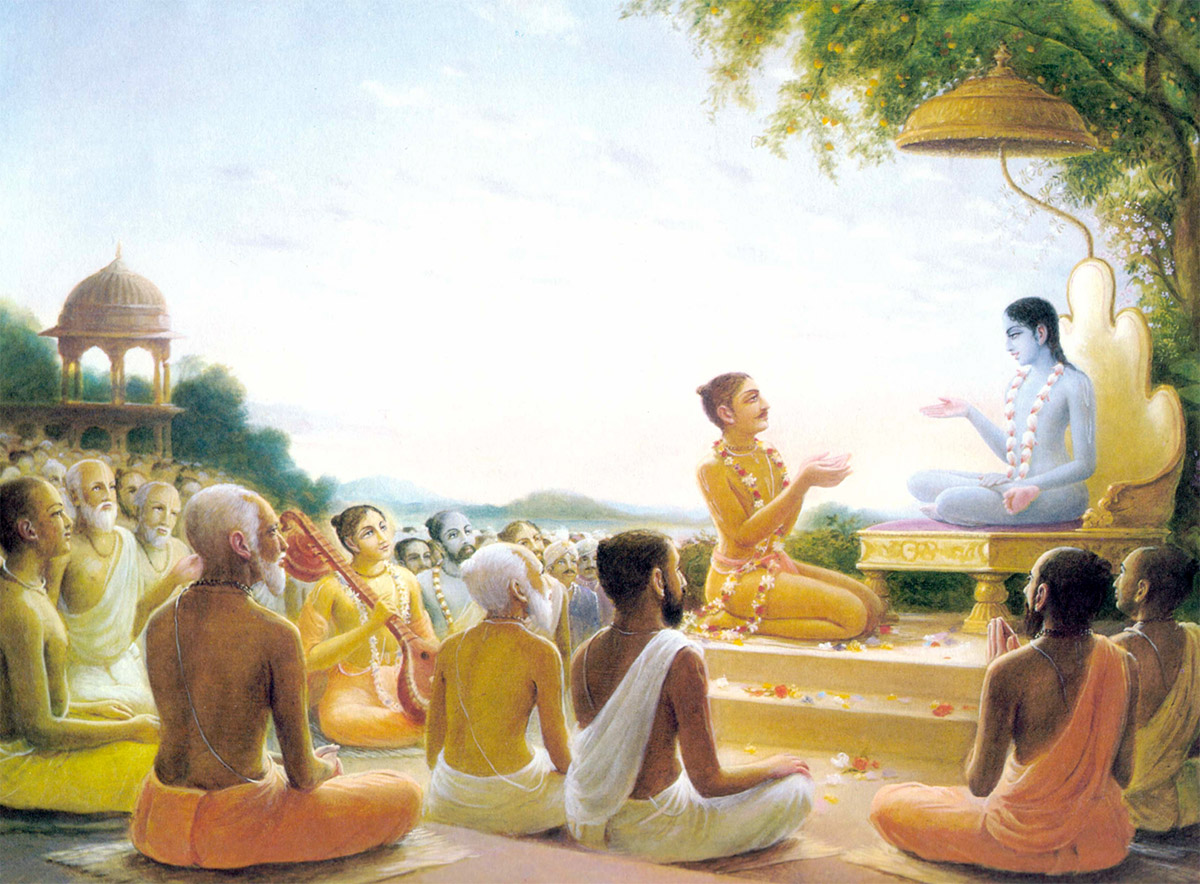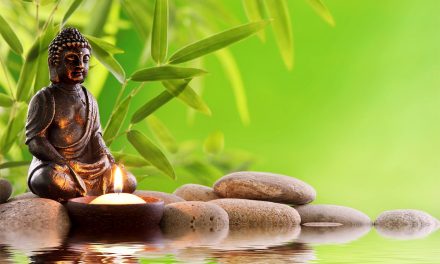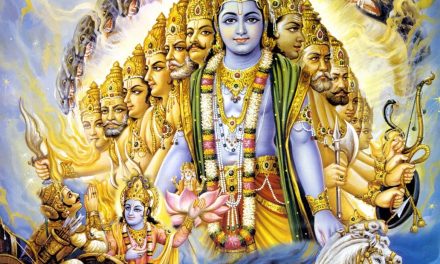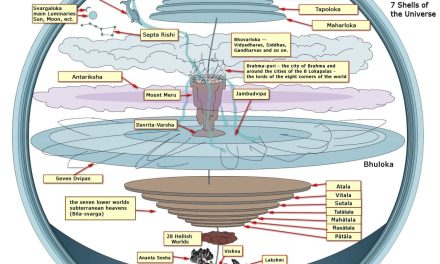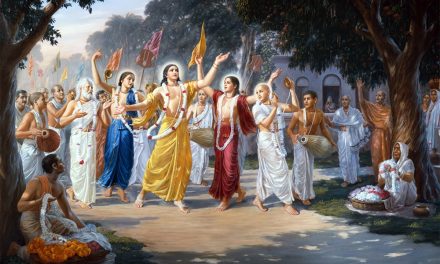(This was originally written by me in 2001 for our email newsletter, Tattva Prakasha.)
The Bhagavata Purana, commonly referred to as the Srimad Bhagavatam, is considered the ripened fruit of all Vedic knowledge. Sri Vyasa Muni, the compiler of the Vedic texts, advises us as follows:
nigama-kalpa-taror galitam phalam
shuka-mukhad amrita-drava-samyutam
pibata bhagavatam rasam alayam
muhur aho rasika bhuvi bhavukah
“O expert and thoughtful men, relish Srimad Bhagavatam, the mature fruit of the desire tree of Vedic literatures. It emanated from the lips of Sri Shuka Muni. Therefore this fruit has become even more tasteful, although its nectarean juice was already relishable for all, including liberated souls.”
Srimad Bhagavatam is the galitam phalam, or ripened fruit, of all Vedic knowledge. It is exactly like amrita, for by hearing its recitation we can cross beyond birth and death.
The Srimad Bhagavatam describes the various incarnations of Lord Hari, and in the process of these descriptions ten important subject matters are explained, namely sarga (the elemental creation), visarga (the secondary creation), sthanam (the planetary systems), poshanam (protection by the Lord), utayah (the creative impetus), manvantara (the periods of Manu), isha-anukatha (the science of God), nirodha (dissolution), mukti (liberation), and ashraya (the supreme shelter).
The reciters of Srimad Bhagavatam have utilized three methods to explain these ten subjects, namely by vedic reference (shrutena), by direct explanation (arthena), and by summary explanations given by the great sages (anjasa).
The following is a brief explanation of each of these ten subjects.
1) Sarga – the elemental creation.
Sarga is defined as follows:
bhuta-matrendriya-dhiyam
janma sarga udahritah
“The elemental creation of sixteen principles of matter – namely the five gross elements (pancha-bhutas), the five objects of sense perception (tan-matras), the five knowledge acquiring senses (jnanendriyas) and the mind – is known as sarga.”
The five gross elements (pancha-bhutas) are earth, water, fire, air and ether; the five objects of sensual perception (tan-matras) are sound, form, taste, smell, and touch; and the five knowledge acquiring senses (jnanendriyas) are the eyes, ears, nose, tongue and skin. Together with the mind, these sixteen principles are created by the first purusha incarnation, Maha-Vishnu. Within these sixteen principles eight other principles exist subtly, making there a total of twenty-four principles of material existence.
2) Visarga – the secondary creation.
Visarga is defined as follows:
brahmano guna-vaishamyad
visargah paurushah smritah
“The secondary creation by Brahma carried out through the interaction of the three modes of nature is known as visarga.”
By manipulating the sixteen original principles of material existence and by the interaction of the three modes of material nature (sattva, rajas and tamas), Lord Brahma carries out a subsequent creation, more properly described as an assembling of universal ingredients.
3) Sthanam – the planetary systems.
Sthanam is defined as follows:
sthitir vaikuntha-vijayah
“The true situation (sthanam) is the realm of Vaikuntha.”
The entire creation by the Lord is to enable the conditioned souls to satisfy their material desire to lord over the material energy. As such, according to their desires, the Lord creates a suitable situation (sthanam) for them to dwell in. Within the universe, these situations can be divided into fourteen main categories, known technically as bhuvanas, or planetary systems, and 8,400,000 sub-categories, commonly known as species of life. From the topmost sthanam of Brahma-loka (the abode of Lord Brahma) down to the lowest sthanam of Patala-loka, all situations are destructible. In every situation the conditioned living entity is conquered by birth and death. Only by attaining to our eternal constitutional situation in the spiritual realm of Vaikuntha can we conquer the birth and death of this material world. Thus the true sthanam of the living entity is the realm of Vaikuntha. All other temporary situations within this material world cause one to become a victim of material suffering, simply shifting from one situation to the next.
4) Poshanam – protection by the Lord.
Poshanam is defined as follows:
poshanam tad anugrahah
“Protection (poshanam) is the causless mercy of the Lord.”
Poshanam can be defined in two ways according to the mentality of the living entity. For the conditioned souls, poshanam refers to material maintenance. It is the Lord who fulfills the desires of all living entities:
nityo nityanam chetanash chetananam
eko bahunam yo vidadhati kaman
“The supreme eternal among all eternals, the supremely conscious among all the conscious living entities – it is that supreme one among the many who fufills the desires of all.”
For the devotees of the Lord, poshanam refers to the Lord’s causeless mercy and protection. Protection from hunger is the lowest form of protection, which the Lord offers to the conditioned living entities. For the devotees, the Lord’s protection is protection from the illusion of maya. The Lord gives the devotee the strength to always remember Him and engage in His devotional service.
5) Utayah – the creative impetus.
Utayah is defined as follows:
utayah karma-vasanah
“The impetus for activity (utayah) is the desire for fruitive work.”
The conditioned soul forgets that the Lord is his eternal protector and maintainer, and thus an impetus for fruitive activity is manifested for one’s self maintenance. This desire for fruitive activity is the driving force behind all work within this material world. The karma-vasanas are the accumulated residue of one’s previous activities. Every material activity we perform creates a residual impresion within our consciousness, which is carried with us life after life. The sum total of these impressions form our creative impetus to work.
The true impetus of the living entity should be to go back to Godhead, to the supreme abode of Vaikuntha, and activities performed in that direction form the right path of work.
6) Manvantara – the change of Manus.
Manvantara is defined as follows:
manvantarani sad-dharmah
“The reign of the Manus (manvantaras) are for establishing the eternal religious principles.”
Manu is the father of mankind, the progenitor, empowered to guide the human race towards self-realization. Manu provides revealed scriptures to mankind which regulate their activities in a manner that will be for their eternal welfare. When the living entities accept such a regulated path, the Lord provides them with all protection by which they may attain their constitutional situation in Vaikuntha. Thus the desire to go back to Godhead and regulated activities performed to achieve that goal form the proper path of action.
7) Isha-anukatha – the science of God.
Isha-anukatha is defined as follows:
avataranucharitam
haresh chasyanuvartinam
pumsam isha-kathah prokta
nanakhyanopabrimhitah
“The science of God (isha-anukatha) describes the incarnations of the Personality of Godhead and His different activities together with the activities of His great devotees.”
The entire material creation is for the ultimate purpose of the living entities’ salvation. When the conditioned living entities utilize the creation for secondary purposes, such as material fruitive activity, the Lord incarnates to reclaim these forgetful souls. The Lord directly delivers living entities by His divine appearance as well as by its recorded history. The Supreme Lord is so potent that simpy by hearing about His transcendental activities in His various incarnations one becomes free from material bondage. Thus the topics of the Lord and His devotees, which constitute the science of God, should be given respectful aural reception.
8) Nirodha – the disolution.
Nirodha is defined as follows:
nirodho ‘syanushayanam
atmanah saha shaktibhih
“The merging of the living entity, along with his conditioned living tendency, with the mystic lying down of the Maha-Vishnu is called the winding up of the cosmic manifestation, or nirodha.”
As we have briefly mentioned before, the entire material creation offers two facilities to the conditioned living entities. The living entities may either utilize it to fulfill their desire to lord it over material nature, or they may utilize it to go back to Godhead, the spiritual abode of Vaikuntha. For the living entities who take advantage of the science of God as propagated by the Manus, and who develop a desire to act in such a regulated manner, the Lord provides them full protection from the material energy and resituates them in their proper situation in Vaikuntha. For the other living entities, who choose to disregard the science of God, the Lord gives them an interim period of relief at the time of dissolution. This temporary period of relief is technically called nirodha, or the winding up of the cosmic manifestation. All the living entities along with their conditional tendencies (vasanas) merge into the body of Maha-Vishnu to await another creation and another opportunity to take up the science of God. Though the physical bodies are given up at this time, the subtle bodies (sukshma-sariras) remain with the living entities along with their latent desires. This is indicated by the words atmanah saha shaktibhih.
9) Mukti – liberation.
Mukti is defined as follows:
muktir hitvanyatha rupam
sva-rupena vyavasthitih
“Liberation (mukti) is the permanent situation of the form of the living entity after he gives up the changeable gross and subtle material bodies.”
Those living entities who develop a desire to act for their ultimate welfare regulate their life according to the instructions of the Manus. Such living entities receive the mercy and protection of the Lord in the form of His divine activities and incarnations, either personally or in its literary form as the science of God. By hearing the narrations of the Lord’s activities these living entities are able to give up all external identification with the principles of material existence and its interaction. Such purified living entities develop their original spiritual bodies and are resituated in their constitutional position in Vaikuntha, the spiritual abode of the Lord. This is technically known as mukti or liberation. The words hitvanyatha rupam indicate that these living entities have become completely free from all material coverings including the sukshma-sarira and related vasanas. The word vyavasthitih indicates the real and eternal sthanam of the living entity – sthitir vaikuntha vijayah.
10) Ashraya – the supreme shelter.
Ashraya is defined in the following three verses:
abhasash ca nirodhash ca
yato ‘sty adhyavasiyate
sa ashrayah param brahma
paramatmeti shabdyate
“The supreme one who is celebrated as the Supreme Being or the Supreme Soul is the supreme source of the cosmic manifestation as well as its reservoir and winding up. Thus He is the supreme shelter, the Absolute Truth.”
yo ‘dhyatmiko ‘yam purushah
so ‘sav evadhidaivikah
yas tatrobhaya-vicchedah
purusho hy adhibhautikah
ekam ekatarabhave
yada nopalabhamahe
tritayam tatra yo veda
sa atma svashrayashrayah
“The individual person possessing different instruments of senses is called the adhyatmic person, and the individual controlling deity of the senses is called adhidaivic. The embodiment seen on the eyeballs is called the adhibhautic person. All three of the above mentioned stages of different living entities are interdependent. In the absence of one, another is not understood. But the Supreme Being who sees every one of them as the shelter of the shelter is independent of all, and therefore He is the supreme shelter.”
The Srimad Bhagavata Purana begins with the Vedanta statement “janmady asya yathah” to bring to our attention the supreme source and shelter of all existence – the ashraya-tattva. In order to explain the transcendence of the ashraya the other nine subjects have been explained.
In all of existence there are factually only two divisions, namely the dependent (para-tantra) and the independent (sva-tantra). The independent (svarat) refers only to that Supreme Lord invoked in the beginning of Srimad Bhagavatam by the words “om namo bhagavate vasudevaya”. Sri Vyasa Muni begins by first offering his obeisances to Bhagavan Sri Krishna (Vasudeva), and then identifies Him as the absolute and independent shelter of everything – janmadyasya yathah svarat satyam param dhimahi. The transcendental Sri Krishna is that tenth subject of Srimad Bhagavatam, and in order to properly describe Him, Sri Vyasa Muni has explained the other nine subject matters.
Studied together, these ten subject matters fully establish the Supreme personality of Godhead, Bhagavan Sri Krishna, as the transcendental Absolute Truth. The Vedanta Sutras begin by instructing us to inquire into the nature of the Absolute Truth – atatho brahma jijnasa. This Srimad Bhagavatam is the perfect companion to that inquiry, as it is the natural commentary to the Vedanta Sutras.
Both the Vedanta Sutras and the Srimad Bhagavatam begin from the point of understanding the ultimate source of everything. Sri Vyasa Muni, the author of these two texts, begins both with the same verse: janmady asya yathah, “From whom everything emanates.” But in the Srimad Bhagavatam he expands and elaborates on this very important philosophical subject in great detail:
janmady asya yatah anvayad itaratas carthesv abhijnah svarat
tene brahma hrda ya adi-kavaye muhyanti yat surayah
tejo-vari-mrdam yatha vinimayo yatra tri-sargo ‘mrsa
dhamna svena sada nirasta-kuhakam satyam param dhimahi
“I meditate upon Lord Sri Krishna because He is the Absolute Truth and the primeval cause of all causes of creation, sustenance and destruction on the manifested universes. He is directly and indirectly conscious of all manifestations, and He is independent because there is no other cause beyond Him. It is He only who first imparted the Vedic knowledge unto the heart of brahmaji, the original living being. By Him even the great sages and demigods are placed into illusion, as one is bewildered by the illusory representations of water seen in fire, or land seen on water. Only because of Him do the material universes, temporarily manifested by the reactionsof the three modes of nature, appear factual, although they are unreal. I therefore meditate upon Him, Lord Sri Krishna, who is eternally existent in the transcendental abode, which is forever free from the illusory representations of the material world. I meditate upon Him, for He is the Absolute Truth.”
Thus Srimad Bhagavatam is the key to unlock the secrets of the Vedanta Sutras. There is no literature in the world as great as this Srimad Bhagavata Purana. The transcendental narations within it give us light in this dark age of Kali yuga:
krishne sva-dhamopagate
dharma-jnanadibhih saha
kalau nashta-drisham esha
puranarko ‘dhunoditah
“This Bhagavata Purana is as brilliant as the sun, and it has arisen just after the departure of Lord Krishna to His own abode, accompanied by religion, knowledge, etc. Persons who have lost their vision due to the dense darkness of ignorance in the age of Kali shall get light from this Purana.”
Questions and Answers
Question: I am doing a project on Hinduism at school, so could you please give me some imformation on the Hindu conception of the Supreme Being.
In Hinduism the concept of the Supreme Being entails comprehension of three different divine features. Though each feature appears unique, factually they are one and the same Supreme Person. This is described in the Vedic text known as Bhagavata Purana as follows:
vadanti tat tattva-vidas
tattvam yaj jnanam advayam
brahmeti paramatmeti
bhagavan iti sabdyate
“The Absolute Truth is realized in three phases of understanding by the knower of the Absolute Truth, and all of them are identical. Such phases of the Absolute Truth are expressed as Brahman, Paramatma, and Bhagavan.”
These three features, known technically as Brahman, Paramatma and Bhagavan can be understood as follows.
Brahman is the all-pervasive impersonal form of God; Paramatma is the localized form of God within the heart of every living entity; and Bhagavan is the personal form of God who resides in His spiritual abode.
These three features are factually the same Supreme Person. This can be understood by a simple analogy as told by our spiritual master Srila Prabhupada:
“These three divine aspects can be explained by the example of the sun, which also has three different aspects, namely the sunshine, the sun’s surface and the sun planet itself. One who studies the sunshine only is the preliminary student. One who understands the sun’s surface is further advanced. And one who can enter into the sun planet is the highest. Ordinary students who are satisfied by simply understanding the sunshine-its universal pervasiveness and the glaring effulgence of its impersonal nature-may be compared to those who can realize only the Brahman feature of the Absolute Truth. The student who has advanced still further can know the sun disc, which is compared to knowledge of the Paramatma feature of the Absolute Truth. And the student who can enter into the heart of the sun planet is compared to those who realize the personal features of the Supreme Absolute Truth.”
There is another story on similar lines:
There once were three brothers who lived in a village. They had never gone to the city before, and they had no understanding of what a train was. One day they went to the city to see for themselves what a train was. As they waited they heard the sound of the train’s whistle, and they turned to another man and asked, “Is that the train?” And the man answered, “Yes.” Hearing this one of the three brothers returned to his village and told everyone that the train is the sound of a whistle. The other two brothers, not being convinced with the answer, waited, and soon they saw the head light of the train in the distance. They turned to another man and asked, “Is that light the train?” The man replied, “Yes.” Hearing this, one of the brothers was satisfied, and he returned to his village and explained how actually a train is not just a sound, but a bright light as well. After waiting some more time, the third brother saw the train pull into the station, and he was surprised at what he saw. There were doors and compartments, and so many people getting in and going out! There were food vendors, and ticket collectors, old men and young children! There was so much variety. After seeing this he was satisfied and he returned to his village to inform everyone what a train actually was. It wasn’t just an impersonal sound or a localized light. It was complete variety.
Thus the Supreme Person possesses three unique features, one impersonal and all-pervading, one localized within the hearts of all living entities, and one as a supreme individual residing in His spiritual abode. To understand the Absolute Truth, one must comprehend all three of these features simultaneously.
If god resides in everybody (as we believe in the soul concept of hinduism), how come He is good, dutiful, and noble in some and wicked and deceitful in another? And if it were our previous actions that decide our state of affairs, then there would have been a time when all were good. How did the soul deviate form the lord?
God resides in everyone’s heart as the Paramatma, accompanying the individual living entity. In the Gita Lord Krishna states this as follows:
isvarah sarva-bhutanam
hrid-dese ‘rjuna tisthati
bhramayan sarva-bhutani
yantrarudhani mayaya
“The Supreme Lord is situated in everyone’s heart, O Arjuna, and is directing the wanderings of all living entities, who are seated as on a machine, made of the material energy.”
As the Paramatma, the Lord’s function is that of an observer and witness. He sees the activities of the individual living entity, but does not interfere in his actions. He directs the wanderings of the living entity by providing knowledge, rememberance and forgetfulness to the conditioned soul according to the souls desires:
sarvasya caham hrdi sannivisto
mattah smrtir jnanam apohanam ca
“I am seated in everyone’s heart, and from Me come remembrance, knowledge and forgetfulness. ”
The activities manifested through the body have no connection with the Paramatma. They are manifested by the desires of the individual living entity (jiva-atma). In every body there are two souls, the individual living entity (jiva-atma) and the Supreme Lord (paramatma). The individual soul is eternally dependent on the Lord, thus even to fulfil his material desires he requires the assistance of the Paramatma. Even to reject the the Lord, he requires the help of the Lord.
The Paramatma is equal to all, for He is situated beyond the dualities of good and bad. In the Gita it is stated:
samo ‘ham sarva-bhutesu
na me dvesyo ‘sti na priyah
ye bhajanti tu mam bhaktya
mayi te tesu capy aham
“I envy no one, nor am I partial to anyone. I am equal to all. But whoever renders service unto Me in devotion is a friend, is in Me, and I am also a friend to him.”
The Paramatma is equal to all and situated beyond all material activities.
The individual soul, on the other hand, is covered by the modes of nature (gunas), and thus according to his conditioning within these modes he may manifest good or bad desires, which lead to good or bad activities. This conditioning within the modes has been built up over countless lives, from time immemorial. At every moment we are increasing our conditioning within various modes of nature by our activities and association. Those who are influenced by the mode of goodness (sattva-guna) have a tendency to perform good activities. Those who are influenced by the lower modes of passion and ignorance (rajo-guna and tamo-guna) have a tendency to commit sinful activities.
The Paramatma witnesses the activities of all the living entities so that He may award the appropriate results to everyone through their karma. The individual soul is only the knower of his own individual body, but the Paramatma is the knower of all bodies simultaneously. Though He appears to be situated in many different bodies, actually He remains as one. It is just like the sun, which appears to be overhead no matter where one stands. For a man in India, the sun appears to be directly overhead, and for another man in China, the sun also appears to be overhead. In a similar manner, the Paramatma appears to be situated separately in everyone’s heart.
The deviation of the soul from the Lord traces back beyond time. Originally we were situated in the marginal spiritual realm of tatastha-shakti. Those who develop a desire to be the Lord are given this material world where they may fulfil that desire. Factually, being parts of God, we are all servants. It would be foolish for the hand to want to become independent from the body. Such is the situation for the soul who wishes to be separate from the Lord. The Lord, being full of love, provides this material world to the deviant soul for two purposes, to allow the soul to act as the Lord of matter and thus fulfil his desire, and to provide an environment where the soul can realize his proper position as a part of God. The entire material existence is like a university which the soul may utilize to come to the proper understanding of who he is – an eternal servant of God.
It is the duty of the part to serve the whole. A part of the body must act to serve the entire body. A member of a country must act to serve the country. A family member must act to serve the family. This is a universal law which functions naturally. The individual souls, being part and parcel of God, have a duty to serve God. When they carry out that duty, they are properly situated. When they choose to ignore the absolute whole, and instead develop selfish desires, at that time they are given this material world.
The individual soul, being quite atomic or infinitesimal, very soon becomes entangled in his fantasy world. Though he comes hoping to be the Lord of matter, he ends up becoming it’s servant. At that time the Lord incarnates to again put him on the proper path of education and enlightenment.
Question: Why is the tilak different for different sampradayas, even though all sampradayas lead to Krishna. Also, if Gaudiya Vaishnavas are an off shoot of the Madhva Sampradaya, why is the tilaka of Madhvacarya different from Gauranga?
The tilak is an external symbol of our surrender to Krishna, or to our object of worship. The shape and material used may differ according to the particular process of surrender the sampradaya follows.
In the Sri Vaishnava sampradaya the tilak is made out of the white mud found in anthills. The scriptures tell us that the mud from the base of a Tulasi plant and the white mud from within the ant hill are both pure and best for making tilak. The Sri Vaishnavas will draw two lines representing the feet of Sri Narayana, and in the middle they will put a red line to represent Lakshmi Devi. The red line was originally made from a red stone found within the ant hill. The ants would usually make their ant hill on top of these red stones. When you rub the stone in water, a red color paint is formed. The category of Shakti is generally represented with the color red in all lines, both Vedic and Tantrik. Because the Sri Vaishnava sampradaya begins with Sri Lakshmi Devi, and because they approach Narayana only through Lakshmi, their tilak reflects this process of surrender. The tilaks of each sampradaya actually depict the siddhanta of the sampradaya.
In the Vallabha sampradaya the tilak worn is generally a single vertical red line. This line represents Sri Yamuna Devi. The form of Krishna worshipped in the Vallabha line is Sri Nathji or Govardhana. The consort of the Govardhana hill is the river Yamuna. Their process of surrender goes through Sri Yamuna Devi.
In the Madhva sampradaya the tilak is made out of Gopichandana mud from Dwaraka. Two vertical lines are made out of Gopichandana to represent the feet of Lord Krishna. This gopichandana tilak is nearly identical to that used in the Gaudiya sampradaya. In between a vertical black line is made from the daily coal of the yajna-kunda. In their sampradaya, the process of worship involved nitya-homa, or daily fire sacrifices to the Lord. The remnant coal of the puja was taken each day to mark the forehead. Underneath the black line, a yellow or red dot was put to indicate Lakshmi or Radha. Those who did not perform daily fire sacrifice would only put the simple gopichandana tilak.
In the Gaudiya sampradaya the tilak is usually made out of the Gopichandana mud. Some lineages prefer to use the mud from Vrindavana. The main tilak is basically identical to the Madhva tilak. The slight difference arises due to the emphasis on nama-sankirtana, or the chanting of the Lord’s names. In Sri Chaitanya’s line, nama-sankirtana is the yajna to be performed in kali yuga, and not the daily fire sacrifice performed in the Madhva sampradaya. As such, the black line made from the ash of the fire sacrifice is not applied in the Gaudiya sampradaya. The second difference arises due to Sri Chaitanya’s process of approaching the Lord. In the Gaudiya line one does not approach Srimati Radharani directly, but always indirectly through the servant. To indicate this, the red dot representing Radha is replaced with a tulasi leaf offered at the base of the Lord’s feet. Only with the mercy of Tulasi Devi can we develop pure devotion to Sri Sri Radha and Krishna.
In the scriptures there are very general descriptions of the procedure for applying tilak. For example it is mentioned that the tilak should be urdhva-pundra, or vertical lines; the body should be marked in twelve locations, etc. But these instructions are very general and leave a lot of the details to the acharyas. Even in a simple point, such as the location of the tilak, one person may interpret the ‘shoulder’ to start from the arm, where as another may interpret it to start higher up near the neck. This is actually the case in the two branches of the Sri Vaishna sampradaya.
The actual design of the tilak will manifest either through divine revelation or through scientific study. An example of divine revelation is the Gaudiya lineage of Sri Shyamananda. Radharani revealed a portion of her broken bangle to Sri Shyamananda, which he used in applying tilak to his forehead. As a result, his followers apply a unique design of tilak from other branches of the Gaudiya sampradaya.
In other cases, an acharya may scientifically analyze the sampradaya siddhanta and compare its compatibility with the tilak they wear. The external purpose of the tilak is to differentiate the followers of a sampradaya from other classes of philosophers, just as one branch of the armed forces wears a uniform to differentiate itself from the other branches. In such a case, the tilak may change when there occurs a shift or branching of the sampradaya due to philosophical views. The newly formed branch may re-analyse the tilak in connection with its siddhanta and make changes that fully reflect their process of surrender. Such is the case among the two branches of the Sri Vaishnava sampradaya. Due to a difference of opinion in regards to the process of surrender, two distinct tilaks emerged.
In any case, the ultimate purpose of tilak is to sanctify oneself and mark the body as the temple of the Lord. The scriptures do not specify in detail the manner that this should be done, and as such it is the acharyas who crystalize the procedures while adhering to the general prescriptions given in the scriptures.

